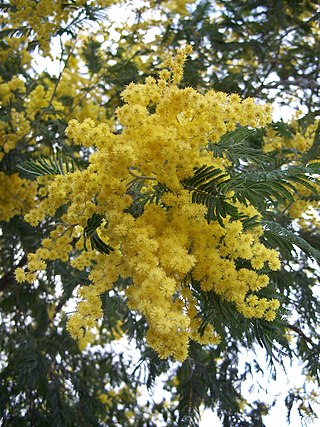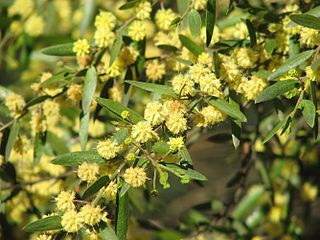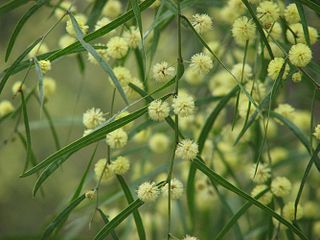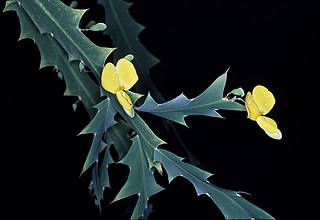
Acacia s.l., known commonly as mimosa, acacia, thorntree or wattle, is a polyphyletic genus of shrubs and trees belonging to the subfamily Mimosoideae of the family Fabaceae. It was described by the Swedish botanist Carl Linnaeus in 1773 based on the African species Acacia nilotica. Many non-Australian species tend to be thorny, whereas the majority of Australian acacias are not. All species are pod-bearing, with sap and leaves often bearing large amounts of tannins and condensed tannins that historically found use as pharmaceuticals and preservatives.

The Mimosoideae are a traditional subfamily of trees, herbs, lianas, and shrubs in the pea family (Fabaceae) that mostly grow in tropical and subtropical climates. They are typically characterized by having radially symmetric flowers, with petals that are twice divided (valvate) in bud and with numerous showy, prominent stamens.

Acacia pycnantha, most commonly known as the golden wattle, is a tree of the family Fabaceae native to southeastern Australia. It grows to a height of 8 m (26 ft) and has phyllodes instead of true leaves. Sickle-shaped, these are between 9 and 15 cm long, and 1–3.5 cm wide. The profuse fragrant, golden flowers appear in late winter and spring, followed by long seed pods. Plants are cross-pollinated by several species of honeyeater and thornbill, which visit nectaries on the phyllodes and brush against flowers, transferring pollen between them. An understorey plant in eucalyptus forest, it is found from southern New South Wales and the Australian Capital Territory, through Victoria and into southeastern South Australia.

Vachellia farnesiana, also known as Acacia farnesiana, and previously Mimosa farnesiana, commonly known as sweet acacia, huisache, or needle bush, is a species of shrub or small tree in the legume family, Fabaceae. Its flowers are used in the perfume industry.

Acacia saligna, commonly known by various names including coojong, golden wreath wattle, orange wattle, blue-leafed wattle, Western Australian golden wattle, and, in Africa, Port Jackson willow, is a small tree in the family Fabaceae. Native to Australia, it is widely distributed throughout the south west corner of Western Australia, extending north as far as the Murchison River, and east to Israelite Bay. The Noongar peoples know the tree as Cujong.

Acacia, commonly known as the wattles or acacias, is a large genus of shrubs and trees in the subfamily Mimosoideae of the pea family Fabaceae. Initially, it comprised a group of plant species native to Africa and Australasia. The genus name is Neo-Latin, borrowed from the Greek ἀκVachellia nilotica, the original type of the genus. In his Pinax (1623), Gaspard Bauhin mentioned the Greek ἀκακία from Dioscorides as the origin of the Latin name.

Acacia mearnsii, commonly known as black wattle, late black wattle or green wattle, is a species of flowering plant in the family Fabaceae and is endemic to south-eastern Australia. It is usually an erect tree with smooth bark, bipinnate leaves and spherical heads of fragrant pale yellow or cream-coloured flowers followed by black to reddish brown pods. In some other parts of the world, it is regarded as an invasive species.

Acacia dealbata, the silver wattle, blue wattle or mimosa, is a species of flowering plant in the legume family Fabaceae, native to southeastern Australia in New South Wales, Victoria, Tasmania, and the Australian Capital Territory, and widely introduced in Mediterranean, warm temperate, and highland tropical landscapes.
Leslie Pedley was an Australian botanist who specialised in the genus Acacia. He is notable for bringing into use the generic name Racosperma, creating a split in the genus, which required some 900 Australian species to be renamed, because the type species of Acacia, Acacia nilotica, now Vachellia nilotica, had a different lineage from the Australian wattles. However, the International Botanical Congress (IBC), held in Melbourne in 2011, ratified its earlier decision to retain the name Acacia for the Australian species, but to rename the African species.

Acacia verniciflua, commonly known as varnish wattle, is a shrub or small tree species that is endemic to Australia. It has an erect or spreading habit, growing to between 1 and 6 metres high, The phyllodes are often sticky and lustrous and vary in length, width and shape. The globular pale-yellow flowerheads appear in the leaf axils from July to November, followed by seedpods that are up to 10 cm long and unconstricted. These contain shiny black seeds. It is often found growing alongside Eucalyptus obliqua where it can dominate the understory.

Acacia stictophylla, also known as Dandenong Range cinnamon wattle, is a species of Acacia that is endemic to Victoria, Australia. The species was first formally described in the botanical journal Muelleria in 2009. Previous to this it was included in the species Acacia leprosa and was often referred to as the "Dandenong Range variant". It is listed as "Rare in Victoria" on the Department of Sustainability and Environment's Advisory List of Rare Or Threatened Plants In Victoria.

Acacia rigens, commonly known as nealie, is an erect or spreading shrub or small tree that is endemic to Australia. Other common names include needle wattle, needlebush acacia, nealia and nilyah.

Acacia euthycarpa is a shrub or small tree species that is endemic to southern Australia. It shares its common names of wallowa or reed-leaf wattle with a similar species Acacia calamifolia. It usually grows as a shrub to between 2 and 4 metres high, but certain forms may be small trees up to 10 metres high. The linear phyllodes are up to 10 cm long, dull green or grey green and have sharply pointed hooked tips. The globular golden flowerheads appear in 2-4 headed racemes between August and October, followed by curved seedpods that are up to 15 cm long.
Muelleria is a peer-reviewed scientific journal on botany published by the Royal Botanic Gardens Melbourne. It focuses on topics relating to plants, algae, and fungi in the southern hemisphere and Australia in particular. The journal was named in honour of Victorian Government botanist Ferdinand von Mueller. Muelleria commenced publication in 1955 with funding from the Maud Gibson Trust. The trust was initiated in 1945 following the donation of £20,000 by Maud Gibson, a daughter of William Gibson, founder of the Foy & Gibson department store chain.

Acacia williamsonii, known colloquially as Whirrakee wattle, is a species of Acacia that is endemic to the Bendigo region of Victoria. Naturalised populations also exist in Southern and Northern NSW.
Arthur Bertram Court was an Australian botanist

Bossiaea bossiaeoides is a species of flowering plant in the family Fabaceae and is endemic to northern Australia. It is much-branched, glabrous shrub with broadly winged stems, winged and lobed cladodes, leaves reduced to small scales, and yellow flowers, sometimes with orange or red blotches.
Marco Duretto is a manager and senior research scientist at the Royal Botanic Gardens Sydney in Australia.

Acacia sporadica, also commonly known as the pale hickory wattle, is a shrub of the genus Acacia and the subgenus Phyllodineae that is native to a small area in Victoria
Daniel J. Murphy is an Australian botanist.
















